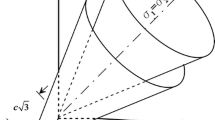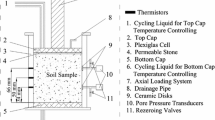Abstract
A linear interpolation function fitting the nonlinear relationship between void ratio and compression modulus was proposed and corresponding strategy guaranteeing calculation accuracy and efficiency was developed for the nonlinear numerical analysis of 3-D large strain thaw consolidation of ice rich frozen soil. It was verified by a series of ice rich thaw consolidation tests that, with the proposed numerical implementation strategy, the calculated results match well with the tested results of pore water pressure and thaw displacement. Further analysis on the different stress-strain relationships shown that the prediction values and accuracies on pore water pressure and thaw displacement of nonlinear relationship is higher than that of linear relationship. This also leads to higher prediction accuracy on thaw consolidation degree and pore water pressure at thawing front of nonlinear relationship.
Access provided by CONRICYT-eBooks. Download conference paper PDF
Similar content being viewed by others
Keywords
1 Governing Equations and Numerical Implementation
When ice rich frozen soil is involved, the large strain consolidation theory is usually employed to describe soil skeleton mechanical behavior and fluid flow in post-thawed domain [1]. Generally, the consolidation theory includes four parts (i.e., kinematic equation, constitutive equation, Darcy’s law and fluid mass conservation equation), where the three dimensional linear constitutive theory us expressed as,
In which, \( \sigma_{ij} \) is total stress tensor, E is Young’s modulus, v is Poisson’s ratio, δij is the Kronecker symbol, and \( \dot{\varepsilon }_{ij} \) is symmetric deformation tensor.
The thermal conductive equations are implemented to detect the post-thawed domain as following,
In Eq. (2), T is temperature (°C), hv (W/m3) is volumetric heat source intensity; c (J/kg·°C) and ξ (W/m·°C) are specific heat and thermal conductivity, respectively; ρ is the media density (kg/m3). Both of the thermal parameters are temperature dependent, and the details can be referred to literatures [2, 3].
As it can be seen in Eq. (2), the linear stress-strain relationship was used in previous three dimensional analysis of frozen soil thaw consolidation [4, 5]. For ice rich frozen soil, the compressibility of which shows strong nonlinearity, and the nonlinear stress-strain relationship must be used to describe the soil skeleton mechanical behaviours. In the following, a nonlinear relationship between void ratio (e) and compression modulus (Es) is used to modify the original linear thaw consolidation theory, i.e.,
where, λ is the slope of K0 compression e-log (stress) curve. The Young’s modulus (E) can be further expressed as,
In numerical analysis, a linear interpolation function Eq. (3) for fitting the nonlinear relationship between void ratio and compression modulus is proposed for guaranteeing calculation accuracy and efficiency as,
where, Es(m) and em are the data points obtained from the K0 compression e-log (stress) curve.
2 Verification and Results Discussion
To verify the applicability of the proposed linear interpolation function for fitting the nonlinear relationship between void ratio and compression modulus, a series of 1-D thaw consolidation tests under different dry unit weight and surcharge loads were conducted, and the corresponding parameters for consolidation calculation are obtained in Table 1.
As the two main indexes representing the thaw consolidation behavior of frozen soil, thaw consolidation degree (TD) and the pore water pressure at thawing front (PPTF) are closely related thaw consolidation ratio (TCR) [2, 6], which is defined as,
where, α is the thawing rate of soil sample, which is related to the thermal properties and boundaries; cv is the consolidation coefficient and defined as,
where, the secant compression modulus (Es0) is used for ease of analyzing the difference between linear and nonlinear relationships.
Figures 1 and 2 show the relationships between thaw consolidation degree (TD), normalized pore water pressure at thawing front (NPPTF) and TCR, where TD and NPPTF are defined as,
where, h(t) is the thaw displacement, \( h_{\hbox{max} } (t) = \frac{{E_{s0} }}{{P_{0} }}x(t) \) and x(t) is the thaw depth at time t. It can be seen that for the calculated results of both stress-strain relationships, NPPTF is proportionally related to TCR, while it is opposite for TD. This indicates that with increase of TCR, more post-thawed pore water is generated, while the rate of drainage (cv) is relatively decreased. Subsequently, the TCD decreases and NPPTF increases. By comparing the calculated results of both relationships (linear and nonlinear), it can be found that for both of the indexes, the linear results are lower than that of nonlinear results, which is due to the calculated differences of both stress-strain relationships on thaw displacement and pore water pressure. In addition, the nonlinear stress-strain relationship shows a higher accuracy on of the TCD and NPPTF (Figs. 1 and 2) than the linear relationship, which indicates the applicability of the proposed linear interpolation function in cold regions engineering when ice rich permafrost is involved.
References
Yao, X.L., Qi, J.L., Wu, W.: Three dimensional analysis of large strain thaw consolidation in permafrost. Acta Geotech. 7(3), 193–202 (2012)
Qi, J.L., Yao, X.L., Yu, F.: Consolidation of thawing permafrost considering phase change. J. Civil Eng. KSCE 17(6), 1293–1301 (2013)
Wang, S.H., Qi, J.L., Yu, F., Yao, X.L.: A novel method for estimating settlement of embankments in cold regions. Cold Reg. Sci. Technol. 88(5), 50–88 (2013)
Sykes, J.F., Lennox, W.C., Charlwood, R.G.: Finite element permafrost thaw settlement model. J. Geotech. Eng. Div. 100(11), 1185–1201 (1974)
Qi, J.L., Yao, X.L., Yu, F., Liu, Y.Z.: Study on thaw consolidation of permafrost under roadway embankment. Cold Reg. Sci. Technol. 81(3), 48–54 (2012)
Morgenstern, N.R., Smith, L.B.: Thaw-consolidation tests on remoulded clays. Can. Geotech. J. 10(1), 25–40 (1973)
Acknowledgements
This work was supported in part by the National Natural Science Foundation of China (No. 41671061) and the research Project of the State Key Laboratory of Frozen Soils Engineering granted to Dr. Xiaoliang Yao (SKLDSE-ZT-28).
Author information
Authors and Affiliations
Corresponding author
Editor information
Editors and Affiliations
Rights and permissions
Copyright information
© 2018 Springer Nature Switzerland AG
About this paper
Cite this paper
Yao, X., Dang, B., Qi, J. (2018). Nonlinear Numerical Analysis of Thaw Consolidation of Ice Rich Frozen Soil. In: Wu, W., Yu, HS. (eds) Proceedings of China-Europe Conference on Geotechnical Engineering. Springer Series in Geomechanics and Geoengineering. Springer, Cham. https://doi.org/10.1007/978-3-319-97115-5_117
Download citation
DOI: https://doi.org/10.1007/978-3-319-97115-5_117
Published:
Publisher Name: Springer, Cham
Print ISBN: 978-3-319-97114-8
Online ISBN: 978-3-319-97115-5
eBook Packages: EngineeringEngineering (R0)






